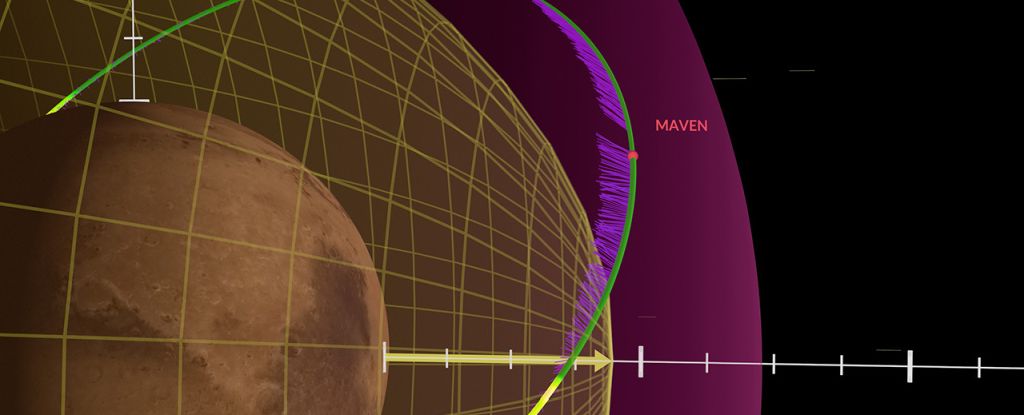A void left in the wake of a particularly powerful gust of solar wind caused the atmosphere of Mars to dramatically balloon outwards.
As the MAVEN spacecraft in orbit around Mars recorded a sudden, sharp drop in solar particles when the wind passed on 26 December 2022, it simultaneously recorded a bizarre and startling change in the Martian atmosphere. The planet’s magnetosphere and ionosphere expanded thousands of kilometers, more than tripling in size.
The last time we saw this phenomenon was in 1999, when a sudden drop in the solar wind caused Earth’s magnetosphere to swell outwards, increasing its volume 100-fold.
It’s a rare glimpse how Mars behaves when its conditions in the Solar System suddenly change, and could give us some insights into how Solar System-like planets interact with their environments around different kinds of stars.
It’s also the kind of measurement that can only be made in situ – demonstrating the value of putting spacecraft in orbit around different worlds in our Solar System, to see how they interact with everything else.
“When we first saw the data, and how dramatic the drop in the solar wind was, it was almost unbelievable,” says astronomer Jasper Halekas of the University of Iowa and the lead author on a new study on the event.
“We formed a working group to study the event, and we have found this time period to be rich with incredible findings.”
The solar wind is more or less constant in the Solar System, and all of the planets are embedded in it. It’s a stream of particles that blow out from the Sun, in all directions, all the time, creating ambient pressure throughout the Solar System, weakening with distance and eventually subsiding at a boundary known as the heliopause.
But the strength of that stream can fluctuate with solar activity. For instance, regions of weakened solar magnetic fields on the surface of the Sun can release a more powerful solar wind, bombarding the system with stronger, more numerous solar particles.
The wind that gusted by Mars on 26 December 2022 was different again. It consisted of two solar winds, a slower one that was swept up and engulfed by a faster wind coming in from behind before continuing outward as one super wind.
MAVEN recorded the higher density of particles from this double solar wind. Once the wind passed by the orbiting observatory detected a significant drop in particle density – a rare void of extremely weak and low density solar wind, and a drop in solar wind pressure, too. The density dropped by a factor of 100. The pressure dropped by a factor of 10.
frameborder=”0″ allow=”accelerometer; autoplay; clipboard-write; encrypted-media; gyroscope; picture-in-picture; web-share” allowfullscreen>
And, as the pressure around it dropped, the Martian atmosphere responded.
The solar wind typically pushes against a planet’s magnetosphere, which on planets like Earth is largely generated by the churning of its molten insides. Now, Mars doesn’t have a global magnetosphere of its own; but it has what is known as an induced magnetic field, created by magnetic fields embedded in the solar wind becoming tangled in Mars’ ionosphere.
This ionosphere and the induced magnetic field therein vastly expanded outwards, like Mars’ atmosphere was taking off a too-tight corset. The induced magnetic field became unmagnetized, and the layer between it and the solar wind – the bow shock – grew much calmer than usual.
This, the researchers say, could yield valuable insights into how atmospheric loss occurs on Mars and planets like it elsewhere in the galaxy. It could be an important piece of the puzzle when identifying what makes a planet habitable.
“We are really getting to see how Mars responds when the solar wind is effectively removed,” Halekas says. “It makes for a great outlier study on what Mars would be like if it were orbiting a less ‘windy’ star.”
The team is presenting its findings at the American Geophysical Union Fall Meeting 2023.





